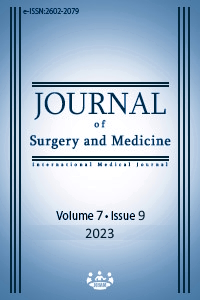The etiological, demographic, and seasonal characteristics of patients with dizziness and vertigo
Characteristics of patients with vertigo
Keywords:
subjective dizziness, benign paroxysmal positional vertigo, seasonal characteristics, quality of lifeAbstract
Background/Aim: Vestibular disorders are common and can negatively affect quality of life and result in workforce losses; they can also be life-threatening diseases. As a result, studies of their etiology and treatment approaches are of particular importance. The aim of this study was to analyze the etiological, demographic, and seasonal characteristics of patients presenting to the Kastamonu Training and Research Hospital Ear, Nose, and Throat (ENT) clinic in Kastamonu, Turkey complaining of vertigo/dizziness.
Methods: In this retrospective cohort study, the files of 1033 patients who presented at the clinic with a report of vertigo/dizziness between September 2020 and September 2021 were examined. The patients’ demographic characteristics, presentation dates, and diagnoses were recorded.
Results: Six hundred and fifty-one patients (63%) were female, and the mean age of the patient cohort was 50.3 years (standard deviation: 16.0 years). Six hundred and twenty-seven patients (60.7%) were identified with chronic subjective dizziness, 302 (29.2%) were identified with benign paroxysmal positional vertigo, 18 (1.7%) were identified with vestibular migraine, 7 (0.7%) were identified with bilateral vestibulopathy, 41 (4.0%) were identified with unilateral vestibulopathy, 16 (1.5%) were identified with vestibular neuritis, 6 (0.6%) were identified with Meniere’s disease, 10 (1.0%) were identified with central vertigo/dizziness, 3 (0.3%) were identified with labyrinthitis and 3 (0.3%) were identified with another form of vertigo/dizziness. An increase in the number of cases was observed in the spring, and the number of patients presenting with vertigo/dizziness decreased thereafter and reached a minimum in the fall (P<0.001).
Conclusion: The most common vestibular disorder was chronic subjective dizziness. Vestibular disorders are more common in women and in the spring season. Although ENT specialists generally focus on pathologies of the ear, vertigo/dizziness are symptoms that may involve several etiologies. Meticulous clinical examinations should be performed; the etiological cause and clinical diagnosis in these cases will dictate additional tests to be requested and therapeutic strategies. Due to the broad diagnostic spectrum of these cases, a multidisciplinary approach is also critical.
Downloads
References
Baydan M, Avcı OS, Yegin S, Binay K, Hancer G, Oztaş S, et al. Etiological and Demographic Characteristics of Patients with Vestibular Symptoms, Retrospective Analysis. J Ankara Univ Fac Med. 2020;73(3):270-5. DOI: https://doi.org/10.4274/atfm.galenos.2020.65477
Yıldırım M, Dogan MT, Keceli AM. Retrospective evaluation of patients consulted to the pediatric neurology department with dizziness/vertigo. Ege Journal of Medicine. 2020;59(2):119-26. DOI: https://doi.org/10.19161/etd.756284
Kocer M, Avcı A, Gulen M, Avcı BS, Satar S, Koc F. Analysis of the patients who applied to emergency medicine with dizziness. Cukurova Med J. 2019;44(2):579-86. DOI: https://doi.org/10.17826/cumj.457648
Rai S, Koirala KP, Yogi N, Karmacharya B, Bhattarai A, Karki B. MRI Findings of Patients Presenting with Vertigo to the Otorhinolaryngology OPD of a Tertiary Care Center of Western Nepal. Eastern Green Neurosurgery. 2020;2(3):3-6. DOI: https://doi.org/10.3126/egn.v2i3.31443
Kantekin Y, Karaaslan O, Dagıstan H, Can IH. Evaluation of anxiety sensitivity, depression and personality characteristics in chronic subjective dizziness patients. J Surg Med. 2020;4(1):33-7. DOI: https://doi.org/10.28982/josam.605104
Ruckenstein M, Stabb J. Chronic subjective dizziness. Otolaryngol Clin North Am. 2009;42:71-7. DOI: https://doi.org/10.1016/j.otc.2008.09.011
Baydan M, Yigit O, Aksoy S. Does vestibular rehabilitation improve postural control of subjects with chronic subjective dizziness? PLoS One. 2020;15(9):e0238436. DOI: https://doi.org/10.1371/journal.pone.0238436
Odman M, Maire R. Chronic subjective dizziness. Acta Otolaryngol. 2008;128(10):1085-8. DOI: https://doi.org/10.1080/00016480701805455
Chen X, Cheng J, Gong J. Deanxit can improve the dizziness, anxiety, and quality of life of patients with chronic subjective dizziness. Am J Transl Res. 2021;13(8):9348-55.
Kaya E, Gumus B. Benign paroksismal pozisyonel vertigo. İncesulu ŞA, Erbek HS, editörler. Vertigoya Güncel Yaklaşım: Tanıdan Tedaviye. 1. Baskı. Ankara: Türkiye Klinikleri; 2020. p.118-23.
Whitman GT, Baloh RW. Seasonality of benign paroxysmal positional vertigo. JAMA Otolaryngol Head Neck Surg. 2015;141:188-9. DOI: https://doi.org/10.1001/jamaoto.2014.2941
Pereira AB, Almeida LA, Pereira NG, Menezes PA, Felipe L, Volpe FM. Seasonality of dizziness and vertigo in a tropical region. Chronobiol Int. 2015;32:585-90. DOI: https://doi.org/10.3109/07420528.2015.1014094
Cao Z, Zhao X, Ju Y, Chen M, Wang Y. Seasonality and Cardio-Cerebrovascular Risk Factors for Benign Paroxysmal Positional Vertigo. Front Neurol. 2020;11:259. DOI: https://doi.org/10.3389/fneur.2020.00259
Meghji S, Murphy D, Nunney I, Phillips JS. The seasonal variation of benign paroxysmal positional vertigo. Otol Neurotol. 2017;38:1315-8. DOI: https://doi.org/10.1097/MAO.0000000000001534
Perez P, Franco V, Cuesta P, Aldama P, Alvarez MJ, Mendez JC. Recurrence of benign paroxysmal positional vertigo. Otol Neurotol. 2012;33:437-43. DOI: https://doi.org/10.1097/MAO.0b013e3182487f78
Gacek RR. Evidence for a viral neuropathy in recurrent vertigo. ORL J Otorhinolaryngol Relat Spec. 2008;70:6-14. DOI: https://doi.org/10.1159/000111042
Downloads
- 353 572
Published
Issue
Section
How to Cite
License
Copyright (c) 2023 Fatma Atalay, Ayhan Kars, Kubra Topal, Sezai Sacid Anbar, Zeynep Yavuz
This work is licensed under a Creative Commons Attribution-NonCommercial-NoDerivatives 4.0 International License.
















